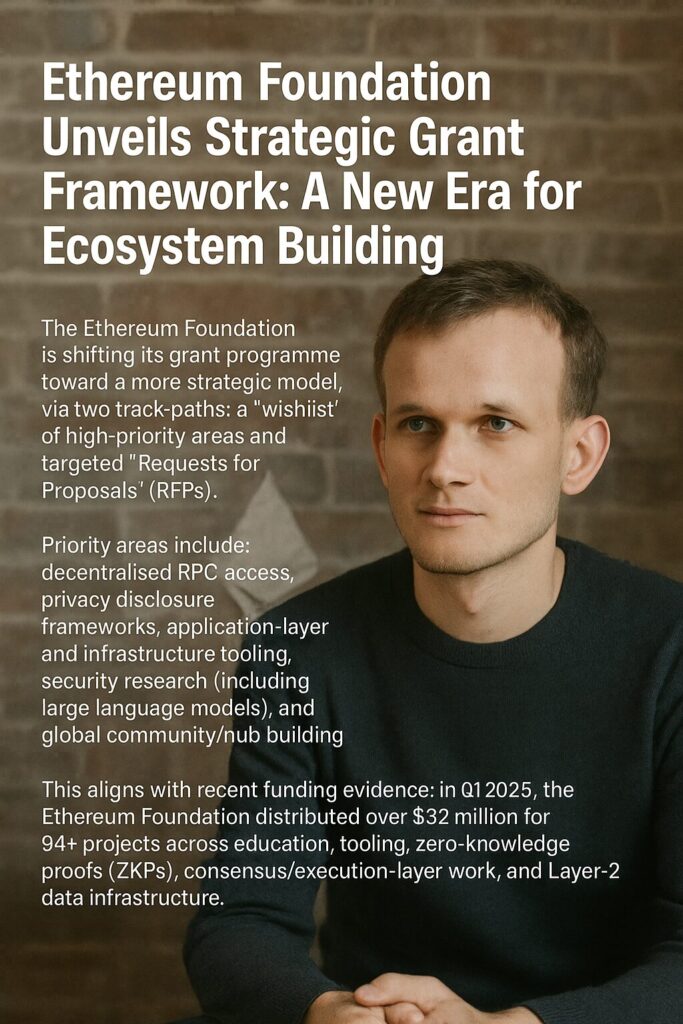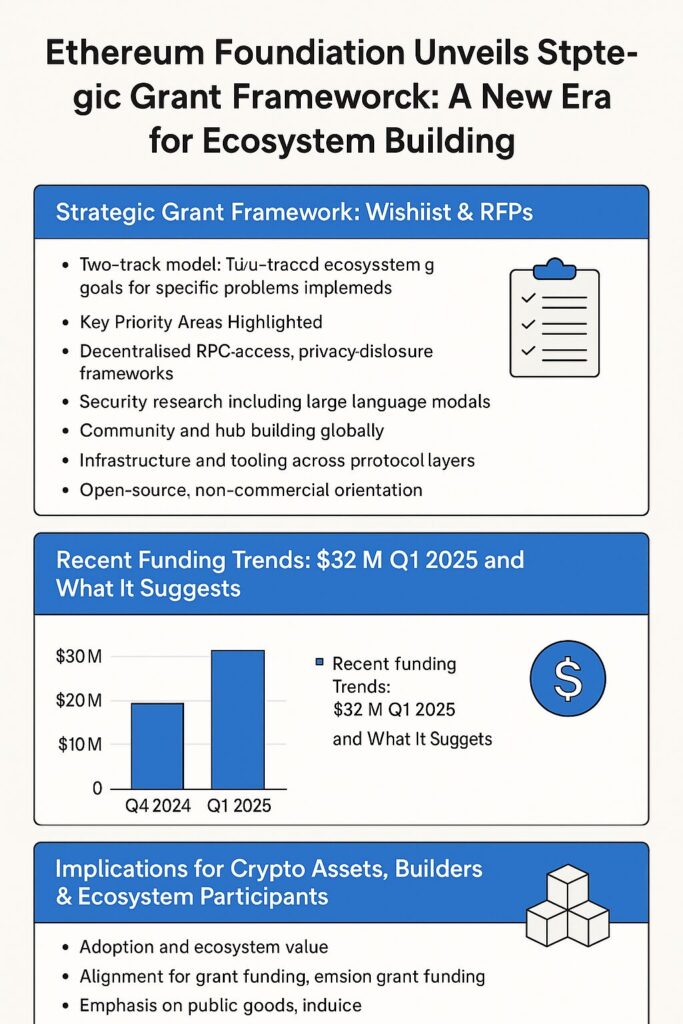
Main Points :
- The Ethereum Foundation is shifting its grant programme toward a more strategic model, via two track-paths: a “wishlist” of high-priority areas and targeted “Requests for Proposals” (RFPs).
- The grants will continue to be open to all eligible parties, but will now be guided by the Foundation’s internal teams’ assessment of the most urgent ecosystem needs.
- Priority areas include: decentralised RPC access, privacy disclosure frameworks, application-layer and infrastructure tooling, security research (including large language models), and global community/hub building.
- This aligns with recent funding evidence: in Q1 2025, the Ethereum Foundation distributed over $32 million for 94+ projects across education, tooling, zero-knowledge proofs (ZKPs), consensus/execution-layer work, and Layer-2 data infrastructure.
- For crypto-asset investors, developers and Web3 practitioners, this signals a clearer signal of where ecosystem growth and funding momentum may land — an important indicator when evaluating where to build, invest or participate.
- The shift means grant-seekers (and associated token-project teams or infrastructure builders) should align proposals to the Foundation’s wishlist and RFPs, not merely a broad “any good idea” opportunity.
- The implications for new crypto assets, blockchain applications and infrastructure: projects aligned to these strategic priorities may benefit from enhanced support, visibility and network-effects, which in turn can positively affect token economics, adoption and ecosystem value.
Strategic Grant Framework: Wishlist & RFPs
In early November 2025, the Ethereum Foundation announced that its flagship grant initiative — the Ecosystem Support Program (“ESP”) — will transition to a two-track model. One track is the “Wishlist”, which defines a set of high-level goals addressing key gaps and progress-opportunities within the Ethereum ecosystem. The second track is “Requests for Proposals” (RFPs), which are tightly scoped calls for solutions to specific problems, with defined requirements, expected deliverables and estimated durations.
This change is framed as a response to increasing application volumes which strained the Foundation’s resources under the previous model. The prior open-ended intake format supported hundreds of projects, but lacked alignment to strategically highest-impact opportunities. Under the new model, while the open application process remains, more of the funding and support allocation will be guided by the priority needs identified by internal teams.
For grant-seekers or infrastructure builders, the message is clear: it will no longer be sufficient to pitch a generic “cool Web3 idea”; alignment to the Foundation’s wishlist priorities or a published RFP will likely enhance chances of selection. For project investors and ecosystem watchers, the benefit is that one can observe where the Foundation is signalling intent — these are likely zones of future builder activity, tooling investment and network support.
Key Priority Areas Highlighted
Among the domains identified in announcements and the Foundation’s website are:
- Distributed RPC access: enabling developers and end-users to call Ethereum network services without relying on centralized providers. This attends to a core infrastructure usability and decentralisation gap.
- Privacy-disclosure frameworks: searching for frameworks to responsibly handle privacy in the Ethereum ecosystem — e.g., zero-knowledge, selective disclosure, privacy-by-design at protocol/application layers.
- Security research including LLM (Large Language Model) applications: one of the RFPs invites solutions that apply large language models to Ethereum protocol security. This signals the convergence of AI and blockchain in the service of trust and audit.
- Community & hub building globally: establishing hubs around the world where Ethereum-community events, developer workshops and ecosystem growth can be facilitated in local regions.
- Infrastructure and tooling across protocol layers: from consensus layer improvements to execution layer performance, developer experience tooling and open-source public-goods projects.
- Open-source, non-commercial orientation: ESP emphasises that grants go toward free/open-source projects, research, public goods and builder-tools rather than front-end dapps, token-launch driven platforms or investment products.
For developers working in Web3 (for example users of Node.js, web3.js, EVM chains) — this is relevant because it suggests that efforts which contribute to core network infrastructure, tooling, or interface layers (for example an SDK for a new wallet or a decentralised RPC provider) may find catalytic funding.
Recent Funding Trends: $32 M Q1 2025 and What It Suggests

According to several reports, in Q1 2025 the Foundation allocated around $32 million (or ~$32.6 million in some sources) across over 90 projects.
Breakdown highlights:
- The largest portion went to Community & Education (32+ initiatives across global workshops, bootcamps, developer outreach)
- Developer Experience & Tooling (16 grants) — including firms working on ZKVM verification, analytics tools, etc.
- Cryptography & Zero-Knowledge Proofs (14 or 16 projects) — emphasising scalable, private infrastructure.
- Consensus layer (7 projects), Execution layer (5), Protocol Growth & Support (5), General Growth and Support (4), Others (~10 projects including decentralisation advocacy, stablecoin research, Layer-2 data infrastructure)
- The Q1 number (~$32M) is a significant increase relative to Q4 2024 (~$11.6M) — pointing to an acceleration in funding pace.
From an investor or builder perspective: the trend toward heavier funding in tooling, infrastructure, ZKP and developer experience suggests that ecosystem value may shift toward builders and infrastructure rather than purely speculative token launches. If you are evaluating new crypto assets or protocols, align to projects that support—or ride—the expansion of infrastructure in these domains.
Implications for Crypto Assets, Builders & Ecosystem Participants
Given these developments, how should readers — many of whom are looking for new crypto assets, income sources or practical blockchain applications — interpret the situation?
- Project selection lens: Projects or tokens that support infrastructure, developer tooling, privacy frameworks, or decentralised access may align with the direction of the Foundation’s support. This may enhance their adoption potential, ecosystem credibility and possibly token value over time.
- Builder momentum: If you are a developer (you noted earlier preference for Node.js/web3.js), this means there may be enhanced opportunities to build components (wallets, decentralised RPC layers, tooling) that align with the Foundation’s priorities — possibly gaining grant funding or ecosystem support.
- Public-goods bias: The emphasis on open-source, non-commercial outputs means that purely token-launch-driven speculative projects may be less attractive to the Foundation’s grant apparatus. Builders who align with open-ecosystem public-good work may yield more network effects.
- Investment insight: For investors seeking next-generation assets, looking at protocols or tokens whose ecosystem is supported via infrastructure grants (especially ZKP, Layer-2, privacy, tooling) may provide better foundation for long-term growth rather than purely hype-based assets.
- Risk and opportunity: Because the Foundation is signalling its funding direction, being early in an infrastructure-aligned project may have upside. Conversely, missing this alignment may result in less ecosystem support, fewer network-effects and lower adoption.
- For ICO/token presale themes: If you are considering token issuance (you previously noted token presale evaluation work) this means that aligning your token value proposition with infrastructure, public-good tooling, or ecosystem builder support may be favourable. It may also increase the chance of recognition or partnership with core ecosystem actors.
- Community and regional growth: The focus on community building globally (hubs, workshops, developer outreach) implies that localised builder ecosystems (for example in Asia, Africa, Latin America) may become stronger — which may open up regional token/project opportunities, developer talent pools and partnerships.
Strategic Takeaways for “Next Win” Crypto Projects
Given the above, here are strategic action points for readers:
- Evaluate whether any token project you are interested in has a component that aligns with Ethereum’s infrastructure priorities: e.g., decentralised RPC provision, privacy frameworks on EVM chains, ZKP tooling, developer SDKs, community building.
- If you are a builder: consider submitting a grant proposal under the new framework (wishlist or RFP) of the Ethereum Foundation. Tailor your idea to the published wishlist items or RFPs (once they are published/updated), and emphasise open-source, high-impact builder tooling rather than token-launch-first.
- If you are launching a token/ICO: ensure that your architecture, white-paper and value proposition clearly articulate how your project contributes to core ecosystem infrastructure or developer/infra tooling — this could increase legitimacy and builder momentum.
- For investors: track grant-awarded projects and categories (e.g., ZKP, Layer-2 tooling, developer SDKs) as possible early indicators of where ecosystem value is being built.
- Monitor upcoming announcements from the Ethereum Foundation’s ESP for newly published “wishlist” items and RFPs — these will act as signals of where strategic investment and builder focus will flow next.
- For community builders and regional ecosystems: exploring running hubs, workshops, developer bootcamps or meet-ups may align well with the Foundation’s earmarked funding for global community growth — an opportunity if you are involved at local or regional level.
Conclusion
The Ethereum Foundation’s move to a strategic grants model — via a clearly defined “wishlist” and targeted RFPs — represents a maturation of its ecosystem-funding approach. For the builder, investor and practitioner community, this is a significant signal: ecosystem growth will increasingly be tethered to infrastructure, tooling, privacy, developer onboarding and open-source public goods rather than purely speculative token-hype. With over $32 million deployed in Q1 2025 alone into tooling, ZKP, education and core infrastructure, the pace is accelerating.
For those searching for the next asset, or building the next blockchain application or infrastructure stack, aligning to these strategic priorities enhances your chances of ecosystem relevance and support. The next wave in crypto will likely be less about short-term token flips, and more about durable developer and infrastructure momentum. Keep your eyes on the Ethereum Foundation’s published priorities (wishlist/RFPs), and position to ride that wave.

